Estrasorb
FULL PRESCRIBING INFORMATION: CONTENTS*
- Rx only
Prescribing Information - BOXED WARNING
- ESTRASORB DESCRIPTION
- CLINICAL PHARMACOLOGY
- ESTRASORB INDICATIONS AND USAGE
- ESTRASORB CONTRAINDICATIONS
- WARNINGS
- PRECAUTIONS
- ESTRASORB ADVERSE REACTIONS
- OVERDOSAGE
- ESTRASORB DOSAGE AND ADMINISTRATION
- HOW SUPPLIED
FULL PRESCRIBING INFORMATION
Rx only
Prescribing Information
BOXED WARNING
ESTROGENS INCREASE THE RISK OF ENDOMETRIAL CANCER
Close clinical surveillance of all women taking estrogen is important. Adequate diagnostic measures, including endometrial sampling when indicated, should be undertaken to rule out malignancy in all cases of undiagnosed persistent or recurring abnormal vaginal bleeding. There is no evidence that the use of "natural" estrogens results in a different endometrial risk profile than synthetic estrogens at equivalent estrogenic doses.
CARDIOVASCULAR AND OTHER RISKS
Estrogens with or without progestins should not be used for the prevention of cardiovascular disease.
The Women’s Health Initiative (WHI) study reported increased risks of myocardial infarction, stroke, invasive breast cancer, pulmonary emboli, and deep vein thrombosis in postmenopausal women during 5 years of treatment with conjugated equine estrogens CE 0.625 mg) combined with medroxyprogesterone acetate (MPA 2.5 mg) relative to placebo (see CLINICAL PHARMACOLOGY, Clinical Studies). Other doses of conjugated estrogens and medroxyprogesterone acetate, and other combinations of estrogens and progestins were not studied in the WHI and, in the absence of comparable data, these risks should be assumed to be similar. Because of these risks, estrogens with or without progestins should be prescribed at the lowest effective doses and for the shortest duration consistent with treatment goals and risks for the individual woman.
ESTRASORB DESCRIPTION
Estrasorb® (estradiol topical emulsion) is designed to deliver estradiol to the blood circulation following topical application of an emulsion. Each gram of Estrasorb® contains 2.5 mg of estradiol hemihydrate USP, EP, which is encapsulated using a micellar nanoparticle technology. Estrasorb® is packaged in foil pouches containing 1.74 grams of drug product. Daily topical application of the contents of two foil pouches provides systemic delivery of 0.05 mg of estradiol per day.
Estradiol hemihydrate USP, EP (estradiol) is a white, crystalline powder, chemically described as (17ß)-estra-1,3,5(10)-triene-3, 17-diol, hemihydrate. The molecular formula of estradiol hemihydrate is C18H24O2, 1/2 H2O, and the molecular weight is 281.4 g/mol.
The structural formula is:
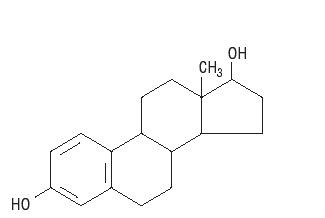
The active ingredient in Estrasorb® is estradiol. The remaining components (soybean oil, water, polysorbate 80, and ethanol) are pharmacologically inactive.
CLINICAL PHARMACOLOGY
Endogenous estrogens are largely responsible for the development and maintenance of the female reproductive system and secondary sexual characteristics. Although circulating estrogens exist in a dynamic equilibrium of metabolic interconversions, estradiol is the principal intracellular human estrogen and is substantially more potent than its metabolites, estrone and estriol, at the receptor level.
The primary source of estrogen in normally cycling adult women is the ovarian follicle, which secretes 70 to 500 mcg of estradiol daily, depending on the phase of the menstrual cycle. After menopause, most endogenous estrogen is produced by conversion of androstenedione, secreted by the adrenal cortex, to estrone by peripheral tissues. Thus, estrone and its sulfate-conjugated form, estrone sulfate, are the most abundant circulating estrogens in postmenopausal women. Estrogens act through binding to nuclear receptors in estrogen-responsive tissues. To date, two estrogen receptors have been identified. These vary in proportion from tissue to tissue.
Circulating estrogens modulate the pituitary secretion of the gonadotropins, luteinizing hormone (LH) and follicle stimulating hormone (FSH) through a negative feedback mechanism. Estrogens act to reduce the elevated levels of these hormones seen in postmenopausal women.
Pharmacokinetics
Absorption
In a multiple-dose study, 125 patients were treated for 28 days once daily with placebo or 1.15 grams, 2.30 grams, or 3.45 grams of Estrasorb® containing 2.5 mg of estradiol per gram. The mean change from baseline in serum estradiol concentrations increased in a dose-dependent manner compared with placebo (Figure 1 below).
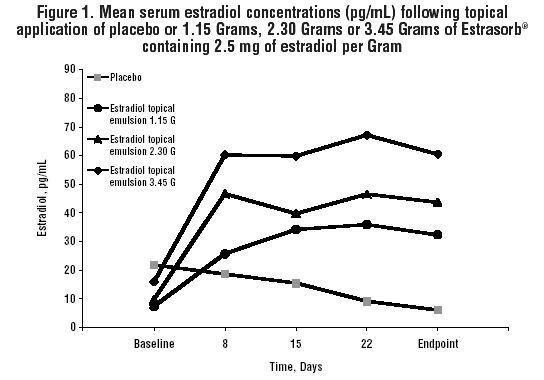
Serum estradiol concentrations were also assessed in a second study involving 200 postmenopausal women, who applied either a 3.45 gram daily dose of Estrasorb® (containing 2.5 mg of estradiol per gram; n = 100) or placebo (n = 100) for 12 weeks. Trough estradiol concentrations in the Estrasorb® treatment group increased from a mean of 8.9 pg/mL at baseline to 58.6 pg/mL and 70.2 pg/mL at Weeks 2 and 4, respectively (Figure 2). Trough levels of Estrasorb® remained at a plateau throughout the rest of the study: 67.3 pg/mL at Week 8 and 63.0 pg/mL at the end of the study.
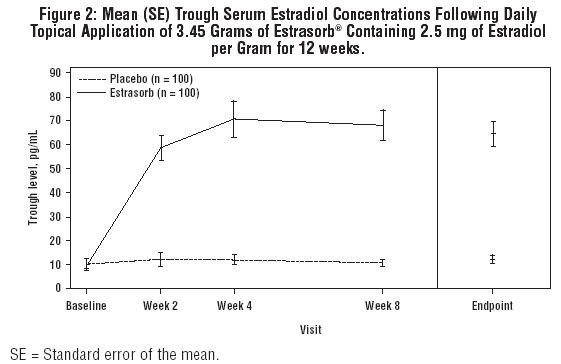
Application of sunscreen 10 minutes prior to the application of Estrasorb® increased the exposure to estradiol by approximately 35%. When sunscreen is applied 25 minutes after the application of Estrasorb®, the increase in exposure to estradiol was approximately 15%. (See PRECAUTIONS.)
Distribution
No specific investigation of the tissue distribution of estradiol absorbed from Estrasorb® in humans has been conducted. The distribution of exogenous estrogens is similar to that of endogenous estrogens. Estrogens are widely distributed in the body and are generally found in higher concentrations in the sex hormone target organs. Estrogens circulate in the blood largely bound to sex hormone binding globulin (SHBG) and albumin.
Metabolism
Exogenous estrogens are metabolized in the same manner as endogenous estrogens. Circulating estrogens exist in a dynamic equilibrium of metabolic interconversions. These transformations take place mainly in the liver. Estradiol is converted reversibly to estrone, and both can be converted to estriol, which is the major urinary metabolite. Estrogens also undergo enterohepatic recirculation via sulfate and glucuronide conjugation in the liver, biliary secretion of conjugates into the intestines, and hydrolysis in the gut followed by reabsorption. In postmenopausal women a significant proportion of the circulating estrogens exists as sulfate conjugates, especially estrone sulfate, which serves as a circulating reservoir for the formation of more active estrogens.
Excretion
Estradiol, estrone, and estriol are excreted in the urine along with glucuronide and sulfate conjugates.
Special Populations
Estrasorb® was only investigated in postmenopausal women. Estrasorb® has not been studied in patients with hepatic or renal impairment.
Drug Interactions
In vitro and in vivo studies have shown that estrogens are metabolized partially by cytochrome P450 3A4 (CYP3A4). Therefore, inducers or inhibitors of CYP3A4 may affect estrogen drug metabolism. Inducers of CYP3A4 such as St. John’s Wort preparations (Hypericum perforatum), phenobarbital, carbamazepine, and rifampin may reduce plasma concentrations of estrogens, possibly resulting in a decrease in therapeutic effects and/or changes in the uterine bleeding profile. Inhibitors of CYP3A4 such as erythromycin, clarithromycin, ketoconazole, itraconazole, ritonavir and grapefruit juice may increase plasma concentrations of estrogens and may result in side effects.
Clinical Studies
Effects on Vasomotor Symptoms
In a 12-week randomized, placebo-controlled clinical trial, a total of 200 postmenopausal women (average age 52 ± 6 years, 79% Caucasian in the Estrasorb® treatment group; average age 51.8 ± 6 years, 72% Caucasian in the placebo treatment group) were assigned to receive Estrasorb® (3.45 grams containing 2.5 mg of estradiol per gram) or placebo for a 12 weeks duration. Estrasorb® was shown to be statistically better than placebo at Weeks 4 and 12 for relief of both the frequency and severity of moderate to severe vasomotor symptoms (p-value <0.001 for Weeks 4 and 12). Frequency results are shown in Table 1. Severity results are shown in Table 2.
| Table 1. Mean Number and Mean Change From Baseline in the Number of Moderate to Severe Vasomotor Symptoms Per Day (Intent-To-Treat Population) | |||
| Time point | Treatment Group | ||
Placebo | Estrasorb® | ||
| Baseline (observed values ) | (N = 100) | (N = 100) | |
| Mean Number of Hot Flushes (SD) | 13.63 (5.48) | 13.05 (5.78) | |
| Week 4 | (N = 97) | (N =96) | |
| Mean Number of Hot Flashes (SD) | 7.46 (6.42) | 4.42 (5.60) | |
| Mean Change from Baseline (SD) | -5.97 (4.76) | -8.56 (6.19) | |
| P-value vs. Placebo | NA | <0.001 | |
| Week 12 | (N =90) | (N =90) | |
| Mean Number of Hot Flushes (SD) | 5.88 (6.17) | 2.00 (3.64) | |
| Mean Change from Baseline | -7.20 (5.39) | -11.11 6.84) | |
| P-value vs. Placebo | NA | <0.001 | |
SD = Standard Deviation; NA = Not applicable | |||
Table 2: Mean Change from Baseline in the Severity Scorea of Hot Flushes Per Day, Intent-to-Treat Population, Most Recent Value Carried Forward | ||
| Time point | Treatment Group | |
Placebo | Estrasorb® | |
Baseline (observed value) | (N=100) | (N=100) |
Mean Severity Score per Day (SD) | 2.44 (0.37) | 2.36 (0.36) |
Week 4 | (N=97) | (N=96) |
Mean Severity Score per Day (SD) | 1.99 (0.81) | 1.47 (1.03) |
Mean Change from Baseline (SD) | -0.45 (0.75) | -0.89 (1.04) |
P-value versus Placebo | NA | <0.001 |
Week 12 | (N=90) | (N=90) |
Mean Severity Score per Day (SD) | 1.88 (0.98) | 0.92 (1.00) |
Mean Change from Baseline (SD) | -0.55 (0.91) | -1.44 (1.04) |
P-value versus Placebo | NA | <0.001 |
SD = Standard deviation; NA = Not applicable | ||
Potential for estradiol transfer
Estradiol was detected on the skin at 2 and 8 hours post-application. Washing the application area with soap and water 8 hours post-application removed detectable estradiol from the application site. Upon physical contact of Estrasorb® application sites by adult males at 2 and 8 hours postapplication over a two-day period in a second study, a mean increase of approximately 25% in serum estradiol concentration was identified. (See DOSAGE AND ADMINISTRATION.)
Women’s Health Initiative Studies
The Women’s Health Initiative (WHI) enrolled a total of 27,000 predominantly healthy postmenopausal women to assess the risks and benefits of either the use of 0.625 mg conjugated equine estrogens (CE) per day alone or the use of 0.625 mg conjugated equine estrogens plus 2.5 mg medroxyprogesterone acetate (MPA) per day compared to placebo in the prevention of certain chronic diseases. The primary endpoint was the incidence of coronary heart disease (CHD) (nonfatal myocardial infarction and CHD death), with invasive breast cancer as the primary adverse outcome studied. A "global index" included the earliest occurrence of CHD, invasive breast cancer, stroke, pulmonary embolism (PE), endometrial cancer, colorectal cancer, hip fracture, or death due to other cause. The study did not evaluate the effects of CE or CE/MPA on menopausal symptoms.
The CE-only substudy is continuing and results have not been reported. The CE/MPA substudy was stopped early because, according to the predefined stopping rule, the increased risk of breast cancer and cardiovascular events exceeded the specified benefits included in the "global index." Results of the CE/MPA substudy, which included 16,608 women (average age of 63 years, range 50 to 79; 83.9% White, 6.5% Black, 5.5% Hispanic), after an average follow-up of 5.2 years are presented in Table 3 below.
a: adapted from JAMA, 2002; 288:321-333 b: includes metastatic and non-metastatic breast cancer with the exception of in situ breast cancer c: a subset of the events was combined in a“global index”, defined as the earliest occurrence of CHD events, invasive breast cancer, stroke, pulmonary embolism, endometrial cancer, colorectal cancer, hip fracture, or death due to other causes d: not included in Global Index * nominal confidence intervals unadjusted for multiple looks and multiple comparisons | |||
Table 3. RELATIVE AND ABSOLUTE RISK SEEN IN THE CE/MPA SUBSTUDY OF WHIa | |||
Eventc | Relative Risk Prempro vs Placebo at 5.2 Years (95% CI*) | Placebo n = 8102 | CE/MPA n = 8506 |
| Absolute Risk per 10, 000 Person-years | |||
| CHD events | 1.29 (1.02-1.63) | 30 | 37 |
| Non-fatal MI | 1.32 (1.02-1.72) | 23 | 30 |
CHD death | 1.18 (0.70-1.97) | 6 | 7 |
Invasive breast cancerb | 1.26 (1.00-1.59) | 30 | 38 |
Stroke | 1.41 (1.07-1.85) | 21 | 29 |
Pulmonary embolism | 2.13 (1.39-3.25) | 8 | 16 |
Colorectal cancer | 0.63 (0.43-0.92) | 16 | 10 |
Endometrial cancer | 0.83 (0.47-1.47) | 6 | 5 |
Hip fracture | 0.66 (0.45-0.98) | 15 | 10 |
Death due to causes other than the events above | 0.92 (0.74-1.14) | 40 | 37 |
| Global Indexc | 1.15 (1.03-1.28) | 151 | 170 |
Deep vein thrombosisd | 2.07 (1.49-2.87) | 13 | 26 |
Verterbral fracturesd | 0.66 (0.44-0.98) | 15 | 9 |
| Other osteoporotic fracturesd | 0.77 (0.69-0.86) | 170 | 131 |
For those outcomes included in the "global index," absolute excess risks per 10,000 person-years in the group treated with CE/MPA were 7 more CHD events, 8 more strokes, 8 more PEs, and 8 more invasive breast cancers, while absolute risk reductions per 10,000 person-years were 6 fewer colorectal cancers and 5 fewer hip fractures. The absolute excess risk of events included in the "global index" was 19 per 10,000 person-years. There was difference between the groups in terms of all-cause mortality. (See BOXED WARNINGS, WARNINGS, and PRECAUTIONS.)
ESTRASORB INDICATIONS AND USAGE
Estrasorb® is indicated for the treatment of moderate to severe vasomotor symptoms associated with menopause.
ESTRASORB CONTRAINDICATIONS
Estrogens should not be used in women with any of the following conditions:
1. Undiagnosed abnormal genital bleeding.
2. Known, suspected, or history of cancer of the breast except in appropriately selected patients being treated for metastatic disease.
3. Known or suspected estrogen-dependent neoplasia.
4. Active deep vein thrombosis, pulmonary embolism or history of these conditions.
5. Active or recent (e.g., within the past year) arterial thromboembolic disease (e.g., stroke, myocardial infarction).
6. Liver dysfunction or disease.
7. Estrasorb® should not be used in patients with known hypersensitivity to its ingredients.
8. Known or suspected pregnancy. There is no indication for Estrasorb® in pregnancy. There appears to be little or no increased risk of birth defects in women who have used estrogens and progestins from oral contraceptives inadvertently during early pregnancy (See PRECAUTIONS.)
WARNINGS
The use of unopposed estrogens in women who have a uterus is associated with an increased risk of endometrial cancer.
1. Cardiovascular disorders.
Estrogen and estrogen/progestin therapy have been associated with an increased risk of cardiovascular events such as myocardial infarction and stroke, as well as venous thrombosis and pulmonary embolism (venous thromboembolism or VTE). Should any of these occur or be suspected, estrogens should be discontinued immediately.
Risk factors for arterial vascular disease (e.g., hypertension, diabetes mellitus, tobacco use, hypercholesterolemia, and obesity) and/or venous thromboembolism (e.g., personal history or family history of VTE, obesity, and systemic lupus erythematosus) should be managed appropriately.
a. Coronary heart disease and stroke. In the Women’s Health Initiative (WHI) study, an increase in the number of myocardial infarctions and strokes has been observed women receiving CE compared to placebo. These observations are preliminary, and the study is continuing. (See CLINICAL PHARMACOLOGY, Clinical Studies.)
In the CE/MPA substudy of WHI an increased risk of coronary heart disease (CHD) events (defined as non-fatal myocardial infarction and CHD death) was observed in women receiving CE/MPA compared to women receiving placebo (37 vs 30 per 10,000 personyears). The increase in risk was observed after the first year and persisted.
In the same substudy of WHI, an increased risk of stroke was observed in women receiving CE/MPA compared to women receiving placebo (29 vs 21 per 10,000 person-years). The increase in risk was observed after the first year and persisted.
In postmenopausal women with documented heart disease (n = 2,763, average age 66.7 years) a controlled clinical trial of secondary prevention of cardiovascular disease (Heart and Estrogen/Progestin Replacement Study; HERS) treatment with CE/MPA (0.625 mg/2.5 mg per day) demonstrated no cardiovascular benefit. During an average follow-up of 4.1 years, treatment with CE/MPA did not reduce the overall rate of CHD events in postmenopausal women with established coronary heart disease. There were more CHD events in the CE/MPA-treated group than in the placebo group in year 1, but not during the subsequent years. Two thousand three hundred and twenty one women from the original HERS trial agreed to participate in an open label extension of HERS, HERS II. Average follow-up in HERS II was an additional 2.7 years, for a total of 6.8 years overall. Rates of CHD events were comparable among women in the CE/MPA group and the placebo group in HERS, HERS II, and overall.
Large doses of estrogen (5 mg conjugated estrogens per day), comparable to those used to treat cancer of the prostate and breast, have been shown in a large prospective clinical trial in men to increase the risks of nonfatal myocardial infarction, pulmonary embolism, and thrombophlebitis.
b. Venous thromboembolism (VTE). In the Woman’s Health Initiative (WHI) study, increase in VTE has been observed in women receiving CE compared to placebo. These observations are preliminary, and the study is continuing. (See CLINICAL PHARMACOLOGY, Clinical Studies.)
In the CE/MPA substudy of WHI, a 2-fold greater rate of VTE, including deep venous thrombosis and pulmonary embolism, was observed in women receiving CE/MPA compared to women receiving placebo. The rate of VTE was 34 per 10,000 person-years in the CE/MPA group compared to 16 per 10,000 person-years in the placebo group. The increase in VTE risk was observed during the first year and persisted.
If feasible, estrogens should be discontinued at least 4 to 6 weeks before surgery of type associated with an increased risk of thromboembolism, or during periods of prolonged immobilization.
2. Malignant neoplasms.
a. Endometrial cancer. The use of unopposed estrogens in women with intact uteri has been associated with an increased risk of endometrial cancer. The reported endometrial cancer risk among unopposed estrogen users is about 2- to 12-fold greater than nonusers, and appears dependent on duration of treatment and on estrogen dose. Most studies show no significant increased risk associated with the use of estrogens for less than 1 year. The greatest risk appears associated with prolonged use, with increased risks of 15- to 24-fold for use over 5 to 10 years or more, and this risk has been shown persist at least 8 to 15 years after estrogen therapy is discontinued.
Clinical surveillance of all women taking estrogen/progestin combinations is important. Adequate diagnostic measures, including endometrial sampling when indicated, should be undertaken to rule out malignancy in all cases of undiagnosed persistent or recurring abnormal vaginal bleeding. There is no evidence that the use of natural estrogens results in a different endometrial risk profile than synthetic estrogens of equivalent estrogen dose. Adding a progestin to postmenopausal estrogen therapy has been shown to reduce the risk of endometrial hyperplasia, which may be a precursor to endometrial cancer.
b. Breast cancer. Estrogen and estrogen/progestin therapy in postmenopausal women has been associated with an increased risk of breast cancer. In the CE/MPA substudy of the Women’s Health Initiative (WHI) study, a 26% increase in invasive breast cancer (38 vs 30 per 10,000 person-years) after an average of 5.2 years of treatment was observed in women receiving CE/MPA compared to women receiving placebo. The increased risk of breast cancer became apparent after 4 years of treatment with CE/MPA. The women reporting prior postmenopausal use of estrogens and/or estrogens with progestin had higher relative risk for breast cancer associated with CE/MPA than those who had never used these hormones. (See CLINICAL PHARMACOLOGY, Clinical Studies.)
In the WHI, no increased risk of breast cancer in CE-treated women compared to placebo was reported after an average of 5.2 years of therapy. These data are preliminary and that substudy of WHI is continuing.
Epidemiologic studies have reported an increased risk of breast cancer in association with increasing duration of postmenopausal treatment with estrogens with or without a progestin. This association was reanalyzed in original data from 51 studies that involved various doses and types of estrogens, with and without progestin. In the reanalysis, an increased risk of having breast cancer diagnosed became apparent after about 5 years of continuous treatment and subsided after treatment had been discontinued for 5 years or longer. Some later studies have suggested that postmenopausal treatment with estrogens and progestin increases the risk of breast cancer more than treatment with estrogen alone.
3. Gallbladder disease. A 2- to 4-fold increase in the risk of gallbladder disease requiring surgery in postmenopausal women receiving estrogens has been reported.
4. Hypercalcemia. Estrogen administration may lead to severe hypercalcemia in patients with breast cancer and bone metastases. If hypercalcemia occurs, the drug should be stopped and appropriate measures taken to reduce the serum calcium level.
5. Visual abnormalities. Retinal vascular thrombosis has been reported in patients receiving estrogens. Discontinue medication pending examination if there is sudden partial or complete loss of vision, or a sudden onset of proptosis, diplopia, or migraine. If examination reveals papilledema or retinal vascular lesions, estrogens should be discontinued.
PRECAUTIONS
A. General
1. Addition of a progestin when a woman has not had a hysterectomy. Studies of the addition of a progestin for 10 or more days of a cycle of estrogen administration, or daily with estrogen in a continuous regimen, have reported a lower incidence of endometrial hyperplasia than would be induced by estrogen treatment alone. Endometrial hyperplasia may be a precursor to endometrial cancer. There are, however, possible risks that may be associated with the use of progestins with estrogens compared to estrogen-alone regimens.These include:
a. A possible increased risk of breast cancer.
b. Adverse effects on lipoprotein metabolism (e.g., lowering HDL, raising LDL)
c. Impairment of glucose metabolism.
2. Elevated blood pressure. In a small number of case reports, substantial increases blood pressure have been attributed to idiosyncratic reactions to estrogens. In a large, randomized, placebo-controlled, clinical trial, a generalized effect of estrogen therapy blood pressure was not seen. Blood pressure should be monitored at regular intervals with estrogen use.
3. Familial hyperlipoproteinemia. In patients with familial defects of lipoprotein metabolism, estrogen therapy may be associated with elevations of plasma triglycerides, leading to pancreatitis and other complications.
4. . Impaired liver function. Although topically administered estrogen therapy avoids first-pass hepatic metabolism, estrogens may be poorly metabolized in patients with impaired liver function. For patient with a history of cholestatic jaundice associated with past estrogen use or with pregnancy, caution should be exercised and in the case of recurrence, medication should be discontinued.
5. Hypothyroidism. Estrogen administration leads to increased thyroid-binding globulin (TBG) levels. Patients with normal thyroid function can compensate for the increased TBG by making more thyroid hormone, thus maintaining free T4 and T3 serum concentrations in the normal range. Patients dependent on thyroid hormone replacement therapy who are also receiving estrogens may require increased doses of their thyroid replacement therapy. These patients should have their thyroid function monitored in order to maintain their free thyroid hormone levels in an acceptable range.
6. Fluid retention. Because estrogens may cause some degree of fluid retention, conditions that might be influenced by this factor, such as a cardiac or renal dysfunction, warrant careful observation when estrogens are prescribed.
7. Hypocalcemia. Estrogens should be used with caution in individuals with severe hypocalcemia.
8. Ovarian cancer. Use of estrogen-only products, in particular for ten or more years, has been associated with an increased risk of ovarian cancer in some epidemiological studies. Other studies did not show a significant association. Data are insufficient to determine whether there is an increased risk with combined estrogen/progestin therapy in postmenopausal women.
9. . Exacerbation of endometriosis. Endometriosis may be exacerbated with administration of estrogens.
A few cases of malignant transformation of residual endometrial implants have been reported in women treated post-hysterectomy with estrogen-only therapy. For patients known to have residual endometriosis post-hysterectomy, the addition of progestin should be considered.
10. . Exacerbation of other conditions. Estrogens may cause an exacerbation of asthma, diabetes mellitus, epilepsy, migraine, porphyria, systemic lupus erythematosus, and hepatic hemangiomas and should be used with caution in patients with these conditions.
11. Application of sunscreen. Estrasorb® should not be used in close proximity sunscreen application because estradiol absorption may be increased. (See CLINICAL PHARMACOLOGY, Pharmacokinetics, Absorption.)
B. Patient Information
Physicians are advised to discuss the contents of the PATIENT INFORMATION leaflet with patients for whom they prescribe Estrasorb®.
C. Laboratory Tests
Estrogen administration should be initiated at the lowest dose approved for the indication and then guided by clinical rather than by serum hormone levels (e.g., estradiol, FSH).
D. Drug/Laboratory Test Interactions
1. Accelerated prothrombin time, partial thromboplastin time, and platelet aggregation time; increased platelet count; increased factors II, VII antigen, VIII antigen, VIII coagulant activity, IX, X, XII, VII-X complex, II-VII-X complex, and beta-thromboglobulin; decreased levels of antifactor Xa and antithrombin III; decreased antithrombin III activity; increased levels of fibrinogen and fibrinogen activity; increased plasminogen antigen and activity.
2. Increased thyroid-binding globulin (TBG) levels leading to increased circulating total thyroid hormone, as measured by protein-bound iodine (PBI), T4 levels (by column or by radioimmunoassay) or T3 levels by radioimmunoassay. T3 resin uptake is decreased, reflecting the elevated TBG. Free T4 and free T3 concentrations are unaltered. Patients on thyroid replacement therapy may require higher doses of thyroid hormone.
3. Other binding proteins may be elevated in serum (i.e., corticosteroid binding globulin, and sex hormone binding globulin), leading to increased circulating corticosteroids and sex steroids, respectively. Free or biologically active hormone concentrations are unchanged. Other plasma proteins may be increased (angiotensinogen/renin substrate, alpha-1-antitrypsin, ceruloplasmin).
4. Increased plasma HDL and HDL-2 cholesterol subfraction concentrations, reduced LDL cholesterol concentration, and increased triglycerides levels.
5. Impaired glucose tolerance.
6. Reduced response to metyrapone test.
E. Carcinogenesis, Mutagenesis, Impairment of Fertility
Long-term continuous administration of natural and synthetic estrogens in certain animal species increases the frequency of carcinomas of the breast, uterus, cervix, vagina, testis, and liver (See BOXED WARNINGS, CONTRAINDICATIONS, and WARNINGS.)
F. Pregnancy
Estrasorb® should not be used during pregnancy. (See CONTRAINDICATIONS.)
G. Nursing Mothers
Estrogen administration to nursing mothers has been shown to decrease the quantity and quality of the milk. Detectable amounts of estrogens have been identified in the milk of mothers receiving this drug. Caution should be exercised when Estrasorb® is administered to a nursing woman.
H. Pediatric Use
Estrogen therapy has been used for the induction of puberty in adolescents with some forms of pubertal delay. Safety and effectiveness in pediatric patients have not otherwise been established.
I. Geriatric Use
There have not been sufficient numbers of geriatric patients involved in studies utilizing Estrasorb® to determine whether those over 65 years of age differ from younger subjects in their response to Estrasorb®.
ESTRASORB ADVERSE REACTIONS
See BOXED WARNINGS, WARNINGS, and PRECAUTIONS.
Because clinical trials are conducted under widely varying conditions, adverse reaction rates observed in the clinical trials of a drug cannot be directly compared to rates in the clinical trials of another drug and may not reflect the rates observed in practice. The adverse reaction information from clinical trials does, however, provide a basis for identifying the adverse events that appear to be related to drug use and for approximating rates.
Table 4 summarizes the treatment-emergent adverse events with Estrasorb® therapy.
Treatment group | |||
Body System/ Preferred term | Statistic | Placebo (n=134) | Estrasorb® 3.45 grams (n=139) |
| Number of subjects with ≥ 1 TEAE | n (%) | 82 (61) | 95 (68) |
| Body as a whole | n(%) | 40 (30) | 49 (35) |
| Headache | n(%) | 17 (13) | 12 (9) |
| Infection | n(%) | 10 (7) | 16 (12) |
| Respiratory | n(%) | 15(11) | 19 (14) |
| Sinusitis | n(%) | 6 (4) | 9 (6) |
| Skin and appendages | n(%) | 7 (5) | 15(11) |
| Pruritus | n(%) | 0 | 5 (4) |
| Urogenital | n(%) | 20 (15) | 44 (32) |
| Breast pain | n(%) | 4 (3) | 14 (10) |
| Endometrial disorder | n(%) | 11 (8) | 21 (15) |
| TEAE=Treatment-emergent adverse event. | |||
The following adverse reactions have been reported with estrogen therapy:
1. Genitourinary system. Changes in vaginal bleeding pattern and abnormal withdrawal bleeding or flow; breakthrough bleeding, spotting; increase in size of uterine leiomyomata; vaginal candidiasis; change in amount of cervical secretion; changes in cervical ectropion; ovarian cancer, endometrial hyperplasia; endometrial cancer.
2. Breasts. Tenderness, enlargement, pain, nipple discharge, galactorrhea; fibrocystic breast changes; breast cancer.
3. Cardiovascular. Deep and superficial venous thrombosis; pulmonary embolism; thrombophlebitis; myocardial infarction; stroke; increase in blood pressure.
4. Gastrointestinal. Nausea, vomiting; abdominal cramps, bloating; cholestatic jaundice; increased incidence of gall bladder disease; pancreatitis.
5. Skin. Chloasma or melasma that may persist when drug is discontinued; erythema multiforme; erythema nodosum; hemorrhagic eruption; loss of scalp hair; hirsutism; pruritis, rash.
6. Eyes. Retinal vascular thrombosis, steepening of corneal curvature, intolerance to contact lenses.
7. Central Nervous System. Headache, migraine, dizziness; mental depression; chorea; nervousness; mood disturbance; anxiety; irritability; insomnia; somnolence; exacerbation of epilepsy.
8. Miscellaneous. Increase or decrease in weight; reduced carbohydrate tolerance; aggravation of porphyria; edema; arthralgia; leg cramps; changes in libido; anaphylactoid/ anaphylactic reactions; hypocalcemia; exacerbation of asthma; increased triglycerides.
OVERDOSAGE
Serious ill effects have not been reported following acute ingestion of large doses of estrogen-containing products by young children. Overdosage of estrogen may cause nausea and vomiting, and withdrawal bleeding may occur in women.
ESTRASORB DOSAGE AND ADMINISTRATION
When estrogen is prescribed for a postmenopausal woman with a uterus, progestin should also be initiated to reduce the risk of endometrial cancer. A woman without a uterus does not need progestin. Use of estrogen, alone or in combination with a progestin, should be with the lowest effective dose and for the shortest duration consistent with treatment goals and risks for the individual women. Patients should be re-evaluated periodically as clinically appropriate (e.g., at 3-month to 6-month intervals) to determine if treatment is still necessary (see BOXED WARNINGS and WARNINGS). For women with a uterus, adequate diagnostic measures, such as endometrial sampling, when indicated, should be undertaken to rule out malignancy in cases of undiagnosed persistent or recurring abnormal vaginal bleeding.
For the treatment of moderate to severe vasomotor symptoms associated with the menopause, the single approved dose of Estrasorb® is 3.48 grams daily. The lowest effective dose of Estrasorb® for this indication has not been determined. (See BOXED WARNINGS and WARNINGS.)
Instructions for daily application of two 1.74-gram foil-laminated pouches
1. Estrasorb® should be applied in a comfortable sitting position to clean, dry skin on both legs each morning. Each foil-laminated pouch of Estrasorb® should be opened individually.
2. Cut or tear the first foil-laminated pouch at the notches indicated near the top of the pouch.
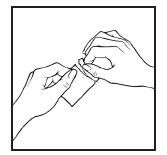
3. Apply the emulsion in the pouch to the top of the left thigh, being careful to push the entire contents from the bottom through the neck of the pouch.
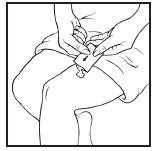
4. Using one hand or both hands rub the emulsion into the entire left thigh and left calf for three minutes until thoroughly absorbed. Rub any excess material remaining on both hands on the buttocks.
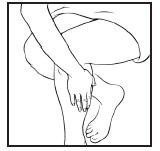
5. Cut or tear the second foil-laminated pouch at the notches indicated near the top of the pouch. Apply the emulsion in the pouch to the top of the right thigh, being careful to push the entire contents from the bottom through the neck of the pouch. Using one hand or both hands rub the emulsion into the entire right thigh and right calf for three minutes until thoroughly absorbed. Rub any excess material remaining on both hands on the buttocks. Estrasorb® absorption was not studied on other parts of the body.
6. Allow the application areas to dry completely before covering with clothing to avoid transfer to other individuals.
7. On completion of Estrasorb® application, both hands should be washed with soap and water to remove any residual estradiol.
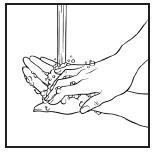
HOW SUPPLIED
Estrasorb® (estradiol topical emulsion), nominal 0.05 mg/day:
Estrasorb® is packaged in foil-laminated pouches. A daily dose of Estrasorb® is two foil-laminated pouches. Each pouch contains 1.74-grams. Each 1.74-gram, foil-laminated pouch contains 4.35 mg of estradiol hemihydrate USP, EP. Each box of Estrasorb® contains fourteen 1.74-gram, foil-laminated pouches, packaged in a 1-month supply carton of 56 pouches.
Store at 20-25°C (68-77°F); excursions permitted to 15-30°C (59-86°F) [see USP]Controlled Room Temperature.
PATIENT INFORMATION
(Updated November 14, 2005)
Estrasorb®
(estradiol topical emulsion)
Read this PATIENT INFORMATION before you start taking Estrasorb and read what you get each time you refill Estrasorb. There may be new information. This information does not take the place of talking to your healthcare provider about your medical condition or your treatment.
What is the most important information I should know about Estrasorb?
• Estrogens increase the chances of getting cancer of the uterus.
Report any unusual vaginal bleeding right away while you are using Estrasorb. Vaginal bleeding after menopause may be a warning sign of cancer of the uterus (womb). Your healthcare provider should check any unusual vaginal bleeding to find out the cause.
• Do not use estrogens with or without progestins to prevent heart disease, heart attacks, strokes or dementia.
Using estrogens with or without progestins may increase your chances of getting heart attacks, strokes, breast cancer, and blood clots. Using estrogens with or without progestins, may increase your risk of dementia, based on a study of women age 65 years or older. You and your healthcare provider should talk regularly about whether you still need treatment with Estrasorb.
What is Estrasorb?
Estrasorb contains an estrogen hormone called estradiol. When applied to the skin as directed below, Estrasorb releases estradiol, which is absorbed through the skin into the bloodstream.
What is Estrasorb used for?
Estrasorb is used after menopause to:
• reduce moderate to severe hot flashes.
Estrogens are hormones made by a woman’s ovaries. The ovaries normally stop making estrogens when a woman is between 45 to 55 years old. This drop in body estrogen levels causes the "change of life" or menopause (the end of monthly menstrual periods).Sometimes, both ovaries are removed during an operation before natural menopause takes place. The sudden drop in estrogen levels causes "surgical menopause."
When the estrogen levels begin dropping, some women develop very uncomfortable symptoms, such as feelings of warmth in the face, neck, and chest, or sudden strong feelings of heat and sweating ("hot flashes" or "hot flushes"). In some women, the symptoms are mild, and they will not need estrogens. In other women, symptoms can be more severe. You and your healthcare provider should talk regularly about whether you still need treatment with Estrasorb.
Who should not use Estrasorb?
Do not start using Estrasorb if you:
• have unusual vaginal bleeding
• currently have or have had certain cancers
Estrogens may increase the chances of getting certain types of cancers, including cancer of the breast or uterus. If you have had cancer, talk with your health care provider about whether you should use Estrasorb.
• had a stroke or heart attack in the past year
•currently have or have had blood clots
• are allergic to Estrasorb or any of its ingredients
See the end of this leaflet for a list of ingredients in Estrasorb.
• think you may be pregnant.
Tell your healthcare provider:
•if you are breast feeding. The hormone in Estrasorb can pass into you’re your breastmilk.
•about all of your medical problems. Your healthcare provider may need to check you more carefully if you have certain conditions, such as asthma (wheezing), epilepsy (seizures), migraine, endometriosis, lupus, problems with your heart, liver, thyroid, kidneys, or have high calcium levels in your blood.
• if you are going to have surgery or will be on bed rest. You may need to stop using Estrasorb.
What are the possible side effects of estrogens?
Less common but serious side effects include:
• Breast cancer
• Cancer of the uterus
• Stroke
• Heart attack
• Blood clots
• Dementia
• Gallbladder disease
• Ovarian cancer
These are some of the warning signs of serious side effects:
• Breast lumps
• Unusual vaginal bleeding
• Dizziness and faintness
• Changes in speech
• Severe headaches
• Chest pain
• Shortness of breath
• Pains in your legs
• Changes in vision
• Vomiting
Call your healthcare provider right away if you get any of these warning signs, or any other unusual symptom that concerns you.
Common side effects include:
• Headache
• Breast pain
• Irregular vaginal bleeding or spotting
• Stomach/abdominal cramps, bloating
• Nausea and vomiting
• Skin irritation, redness, or rash may occur at the site of application
• Hair loss
Other side effects include:
• High blood pressure
• Liver problems
• High blood sugar
• Fluid retention
• Enlargement of benign tumors of the uterus ("fibroids")
• Vaginal yeast infection
These are not all of the possible side effects of Estrasorb. For more information, ask your healthcare provider or pharmacist.
What can I do to lower my chances of getting a serious side effect with Estrasorb?
• Talk with your healthcare provider regularly about whether you should continue using Estrasorb.
• If you have a uterus, talk to your healthcare provider about whether the addition of a progestin is right for you.
• See your healthcare provider right away if you get vaginal bleeding while using Estrasorb.
• Have a breast exam and mammogram (breast X-ray) every year unless your healthcare provider tells you something else. If members of your family have had breast cancer or if you have ever had breast lumps or an abnormal mammogram (breast x-ray examination), you may need to have breast exams more often.
• If you have high blood pressure, high cholesterol (fat in the blood), diabetes, are overweight, or if you use tobacco, you may have higher chances of getting heart disease. Ask your healthcare provider for ways to lower your chances for getting heart disease.
How should I use Estrasorb?
Estrasorb should be used only as long as needed. You and your healthcare provider should talk regularly (for example, every 3 to 6 months) about whether you still need treatment with Estrasorb.
Estrasorb is an emulsion that is applied each day to the skin of both thighs and calves. It is not known if Estrasorb will be absorbed as well if applied to other parts of the body. Estrasorb is packaged in foil pouches. A daily dose of Estrasorb is two foil pouches. Do not open the pouches until just before you apply Estrasorb.
Apply Estrasorb in the morning. If you shower or take a bath, be sure your skin is before using Estrasorb. Do not apply Estrasorb to any skin on your thighs and calves that appears to be red or irritated. Do not apply sunscreen and Estrasorb at the same time because sunscreen may affect the amount of estradiol you absorb.
How to apply Estrasorb
• Estrasorb is best applied when you are sitting comfortably. The skin on both legs should be clean and dry.
• Cut or tear the first pouch across the notches to open it (Diagram 1).
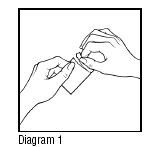
• Place the pouch flat on top of your left thigh, with the open end facing your knee. Hold the other end with one hand and use the forefinger of your other hand to push all of the contents of the pouch onto your left thigh (Diagram 2).
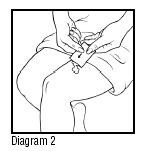
• With one hand or both hands rub the material into your entire left thigh and left calf for three minutes or until thoroughly absorbed (Diagram 3).
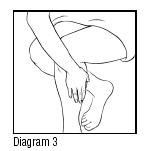
Rub any excess material remaining on the hands on your buttocks.
• Cut or tear the second pouch across the notches to open it (see Diagram 1). Place the pouch flat on top of your right thigh, with the open end facing your knee. Hold the unopened end with one hand and use the forefinger of your other hand to push all of the contents of the pouch onto your right thigh (see Diagram 2).
• With one hand or both hands rub the material into your entire right thigh and right calf for three minutes until thoroughly absorbed (see Diagram 3). Rub any excess material remaining on the hands on your buttocks.
• To reduce the chances of Estrasorb transfer to other individuals upon contact, allow the application areas to dry completely and cover with clothing.
• Wash your hands with soap and water after you have finished the applications to ensure that any excess material has been removed (Diagram 4).

If you forget to apply Estrasorb in the morning just apply Estrasorb as soon as you remember. Do not apply Estrasorb more than once each day.
General information about the safe and effective use of Estrasorb.
Medicines are sometimes prescribed for conditions that are not mentioned in patient information leaflets. Do not use Estrasorb for conditions for which it was not prescribed. Do not give Estrasorb to other people, even if they have the same symptoms you have. It may harm them.
Keep Estrasorb out of the reach of children.
This leaflet provides a summary of the important information about Estrasorb. If you would like more information, talk with your healthcare provider or pharmacist. You can ask for information about Estrasorb that is written for health professionals. You can get more information by calling the toll free number (1-800-230-0375).
What are the ingredients in Estrasorb?
17ß‚-estradiol, Soybean oil, Water, Polysorbate 80, Ethanol
Manufactured by: Novavax, Inc. Malvern, PA 19355
Distributed by: Esprit Pharma, East Brunswick, NJ 08816
Medical Inquiries: 1-866-230-0375
Estrasorb is a registered trademark of Novavax.
© 2005 Esprit Pharma
EST-0001 Issued January 2006
Estrasorbestradiol EMULSION
| |||||||||||||||||||||||||||||||||||||||||||||||||||||||||||